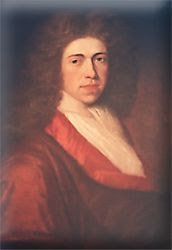
When a piece of current news surfaces I like to know whether there exists any kind of Flemish connection. Today Chelsea Clinton was married in the quaint village of Rhinebeck, New York. As luck would have it, there is indeed a Flemish connection.

The Village of Rhinebeck is the scene of Chelsea Clinton's marriage. Simplistic guides mention in passing that the Village was settled by "Dutch" settlers in 1686. But the reality is that the town was founded and settled by Hendrick (or Henry) Beekman. Beekman, who is pictured below in flowing curls and dressed in red, later united his family (through marriage) to the powerful Robert Livingston clan (of Revolutionary War fame).

Hendrick Beekman was a son of the longest serving mayor of New York (then of course called Nieuw Amsterdam): William (or Willem or Wilhelmus) Beeckman. Willem Beeckman (or Beekman - pictured below in light brown wavy hair, a red cravat and a dark outfit) was the grandson of two prominent Biblical scholars and translators. His paternal grandfather, for whom he was named, came from a line of Protestants who emigrated to Holland from Cologne. Beeckman's maternal grandfather, Willem (or William) Baudert (or Baudart or Baudartius), was the more prominent of the two. Baudartius was a Flemish scholar of Hebrew, an engraver, and one of the officially appointed translators of the first true Dutch-language Bible (called the Statenbijbel) . This was the required Bible for the Netherlands as well as Nieuw Nederland ofte Nova Belgica.

Baudartius (pictured below), whose childhood was spent in the "Dutch" (=Flemish) colony at Sandwich, England, was born in the Flemish town of Deinze which today is part of the province of East Flanders in Belgium. Baudartius was fluent in English, Dutch and French (as well as a ready translator of Latin and Hebrew). Baudartius played an important role at the Synod of Dort (or Dordrecht) - along with other prominent exiled Protestant Flemings such as Gomarus (whom the Pilgrims knew at Leyden), Petrus Plancius (who provided maps for Henry Hudson as well as for the Dutch East and West India Companies - VOC/WIC) and Johannes De Laet (who wrote the first account of the colony at Nieuw Nederland - and about whom more in a future posting).

Like Emmanuel Van Meteren and Johannes De Laet, Baudartius would see his offspring emigrate to Nieuw Nederland ofte Nova Belgica. But their contribution to American history did not end with William Beeckman's mayoralty of New York nor with Henry Beekman's founding of Rhinebeck, NY. Ultimately, Baudartius' descendants would number in the millions in North America and include among the more prominent, George Herbert Walker Bush and George W. Bush, the 41st and 43rd Presidents of the United States (their link to Baudartius is outlined in Dutch here).

So as you gaze at the photos of what the press terms a wedding of "American royalty" in Rhinebeck, New York, remember that a thin historical thread links this village of Rhinebeck, New York to a similarily quiet town of Deinze, East Flanders. Note also that at the back of another American story lies a Fleming from the diaspora.
Copyright 2010 by David Baeckelandt. All rights reserved. No reproduction in any format permitted without my express written approval.





















